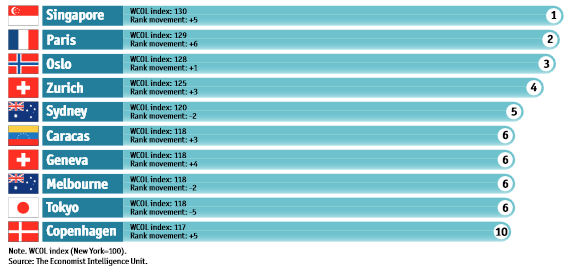Internationales Recruiting: Cost-of-Living Index
Herausforderungen im Cross-Border-Recruiting
Wer bei der Personalbeschaffung davon ausgeht, dass Fachkräftemangel, Demografiewandel, Diversity und Frauenquote die allgegenwärtigen Themen sind die den Recruiter beschäftigen, sollte sich auf Überraschungen einstellen, wenn es um Cross-Border-Recruiting geht. Für die Personalbeschaffung im internationalen Context müssen zusätzliche Hausaufgaben erledigt werden. Es geht um die Vergleichbarkeit von Anforderungsprofilen, landesspezifische Aspekte des Arbeitsrechts, der korrekten Darstellung und Vergleichbarkeit des Compensation & Benefit Packages und nicht zuletzt um die Infrastruktur am Arbeitsort. Work-Live-Balance bekommt einen neuen Touch wenn es um die Lebensqualität im Ausland geht. Darüberhinaus sind die Lebenshaltungskosten ein Element im internationalen Recruiting, die in Bewerbungsgesprächen früher oder später auf den Tisch kommen.

Nun hat das renommierte britische Wirtschaftsmagazin „The Economist“ den aktuellen Cost-of-Living Index neu berechnet, eine kostenlose Zusammenfassung ist hier erhältlich: http://pages.eiu.com/WCOL2014_Register.html
Despite Abenomics driving consumer confidence and price inflation, a weaker yen has pushed Osaka and Tokyo away from the top of the cost of living ranking. This has paved the way for Singapore, which has been steadily moving up the ranking over the last decade, to claim the unenviable title of world’smost expensive city. Singapore’s rising price prominence has been steady rather than spectacular. The city-state was 18th most expensive ten years ago and has actually seen the cost of living compared with New York City decline over the last 12 months. However, over the last decade a 40% currency appreciation, coupled with solid price inflation, has consistently pushed Singapore up the ranking.The city also has some structurally expensive items that skew the overall cost of living upwards. For example, car costs have very high related certificate of entitlement fees attached to them, which makes Singapore significantly more expensive than any other location when it comes to running a car. As a result, transport costs in Singapore are almost three times higher than in New York. In addition, as a city-state with very few natural resources to speak of, Singapore is reliant on other countries for energy and water supplies, making it the third most expensive destination for utility costs. Equally, the proliferation of expensive malls and boutiques on Orchard Road (Singapore’s retail hub) import luxury European brands to satisfy a wealthy and fashion conscious consumer base. This means that Singapore is the priciest place in the world in which to buy clothes.

Mit feiner britischer Ironie adressiert The Economist auch die Aufstellung der preiswertesten Städte weltweit: „Cheap but not always cheerful“.





